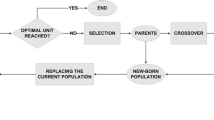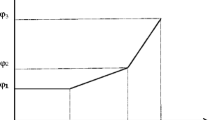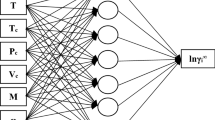Abstract
This work focuses on problems regarding empirical retention modelling and optimization of separation in ion chromatography. Influences of eluent flow rate and concentration of eluent competing ion (OH−) on separation of seven inorganic anions (fluoride, chloride, nitrite, sulphate, bromide, nitrate, and phosphate) were investigated. Artificial neural networks and multiple linear regression retention models in combination with several criteria functions were used and compared in global optimization process. It can be seen that general recommendations for optimization of separation in ion chromatography is application of chromatography exponential function criterion in combination with artificial neural networks retention model.
Similar content being viewed by others
References
Schoenmakers PJ (1986) Optimisation of Chromatographic Selectivity, Elsevier, Amsterdam
Berridge JC (1988) Techniques for the Automated Optimisation of HPLC Separations, Wiley, New York
Snyder LR (1997) Practical HPLC Method Development, 2nd ed., Wiley, New York
Snyder LR, Dolan JW, Lommen DC (1989) J Chromatogr 485:65–89
Heinisch S, Lesellier E, Podevin C, Rocca JL, Tchapla A (1997) Chromatographia 44:529–537
Torres Lapasió JR, García Alvarez-Coque MC, Baeza Baeza JJ (1997) Anal Chim Acta 348:187–196
Madden JE, Haddad PR (1998) J Chromatogr A 829:65–80
Madden JE, Haddad PR (1999) J Chromatogr A 850:29–41
Gjerde DT, Schmuckler G, Fritz JS (1980) J Chromatogr 187:35–45
Haddad PR, Cowie CE (1984) J Chromatogr 303:321–330
Jenke DR, Pagenkopf GK (1984) Anal Chem 56:85–88
Jenke DR, Pagenkopf GK (1984) Anal Chem 56:88–91
Jenke DR (1984) Anal Chem 56:2674–2681
Maruo M, Hirayama N, Kuwamoto T (1989) J Chromatogr 481:315–322
Jenke DR (1994) Anal Chem 66:4466–4470
Hajos P, Horvath O, Denke V (1995) Anal Chem 67:434–441
Noviè Ma, Zupan J, Noviè Mi (2001) J Chromatogr A 922:1–11
Sacchero G, Buzzoniti MC, Sarzanini C, Mentasti E, Metting HJ, Coenegracht P MJ (1998) J Chromatogr A 799:35–45
Madden JE, Avdalovic N, Jackson PE, Haddad PR (1999) J Chromatogr A 837:65–74
Havel J, Madden JE, Haddad PR (1999) Chromatographia 49:481–488
Madden JE, Avdalovic N, Haddad PR, Havel J (2001) J Chromatogr A 910:173–179
Srecnik G, Debeljak Z, Cerjan-Stefanović Š, Bolanèa T, Nović M, Lazarić K, Gumhalter – Luliæ Z (2002) Croat Chem Acta 75:713–725
Sreènik G, Debeljak Z, Cerjan – Stefanoviæ Š, Noviè M, Bolanća T (2002) J Chromatogr 973:47–59
Strasters JK, Breyer ED, Rodgers AH, Khaledi MG (1990) J Chromatogr 511:335–343
Lema M, Otero J, Marcó J (1991) J Chromatogr 547:113–120
Sekulic S, Haddad PR (1989) J Chromatogr 485:501–515
Heinisch S, Rocca JL (1995) Chromatographia 41:544–552
Carda-Broch S, Torres-Lapasió J R, García-Alvarez-Coque MC (1999) Anal Chim Acta 396:61–74
López-Grío SJ, Vivó-Truyols G, Torres-Lapasió JR, García-Alvarez-Coque MC (2001) Anal Chim Acta 433:187–198
Li J (1997) Anal Chem 69:4452–4462
Di Marco VB, Bombi GG (2001) J Chromatogr A 931:1–30
Nikitas P, Pappa-Louisi A, Papageorgiou A (2001) J Chromatogr A 912:13–29
Pápai Zs, Pap TL (2002) Analyst 127:494–498
Li J (2002) J Chromatogr A 952:63–70
Torres-Lapasió JR, Villanueva-Camañas RM, Sanchis-Mallols JM, Medina- Hernández MJ, García-Alvarez-Coque MC (1994) J Chromatogr A 677:239–253
Torres-Lapasió JR, Baeza-Baeza JJ, García-Alvarez-Coque MC (1997) Anal Chem 69:3822–3831
Caballero RD, García-Alvarez-Coque MC, Baeza-Baeza JJ (2002) J Chromatogr A 954:59–76
Acknowledgments.
The authors would like to thank for the assistance and comments of Goran Srečnik (Pliva, Pharmaceutical Industry, Zagreb, Croatia) and Željko Debeljak (Clinical Hospital Osijek, Osjek, Croatia).
Author information
Authors and Affiliations
Corresponding author
Rights and permissions
About this article
Cite this article
Bolanča, T., Cerjan-Stefanović, Š. & Novič, M. Application of Artificial Neural Network and Multiple Linear Regression Retention Models for Optimization of Separation in Ion Chromatography by Using Several Criteria Functions. Chroma 61, 181–187 (2005). https://doi.org/10.1365/s10337-004-0487-2
Received:
Revised:
Accepted:
Published:
Issue Date:
DOI: https://doi.org/10.1365/s10337-004-0487-2




